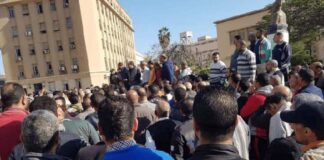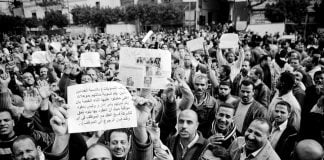Three years ago more than a million people packed Egypt’s Tahrir square celebrating the fall of the hated dictator, Hosni Mubarak. The removal of Mubarak, who ruled Egypt with an iron fist for almost 30 years, was a key event in the Arab spring that inspired hundreds of millions.
Today things are not so bright. The 2011 revolution removed the dictator but not the state behind the dictator—and now that state wants to impose a new dictator, General El-Sisi.
The military used the third anniversary of the revolution to show its grip on power. Its supporters carried pictures of El-Sisi in a demonstration that occupied Tahrir Square, the symbolic heart of the revolution.
But revolutionary opponents of the military also courageously took to the streets. Two thousand joined a demonstration outside the Journalists’ Syndicate in Cairo, facing down snipers and police who used live ammunition against them.
Separate protests by the Muslim Brotherhood continue to face the bloodiest repression. Up to 100 were killed and 1000 arrested that day.
As Wassim Wagdy of Egypt’s Revolutionary Socialists explains, “The army is pushing counter revolution…It has murdered and jailed members of the Muslim Brotherhood and has gone on to arrest some of the activists of the left who are symbols of the revolution. It has used a shoot to kill policy on university campuses.”
The Western press is beginning to write off the revolution. But it is far too early to say it is over.
One indication of the fragility of the military’s position was the constitutional referendum in January. The military hoped for an 80 per cent turnout, but only 38.6 per cent voted. Much of the youth remains alienated from the regime.
While the pro-regime demonstrations on 25 January were large, they were nothing compared to the millions who’ve packed Tahrir square on numerous occasions since 2011 to force change.
As recently as 30 June last year more than 14 million people mobilised across Egypt demanding the removal of the Muslim Brotherhood government led by President Mohamed Morsi.
While the military used the protests as an excuse to stage a coup, they were driven by opposition to the Brotherhood’s efforts to entrench its own power and failure to deliver on the economic demands of the revolution. The military needed to act or watch the people take the initiative themselves.
Labour movement
While the military have had some success at regaining control of the streets and squares, they are yet to break the labour movement, which played a key role in the removal of Mubarak.
As Solidarity goes to press there is renewed ferment in Egypt’s industrial heartland. “Egypt has witnessed the largest upsurge of strikes and industrial action this year”, reported Mada Masr in mid February. This included 20,000 on strike for over a week in Egypt’s largest textile company and a nationwide doctors’ strike.
This comes in the wake of a large and successful strike by workers in Egypt’s state-owned iron and steel company in December.
Popularity
The removal of the Brotherhood in June gave the military a popularity boost but this can change rapidly. The military were popular following the removal of Mubarak, but their failure to pursue the human rights abusers and to organise elections saw people take to the streets in massive numbers in November 2011, forcing them to move to the background.
Another problem for El-Sisi is Egypt’s week economy. If he attempts to restore its health by attacking people’s already pathetic living standards, his standing will plunge.
The one advantage he has is the lack of a political alternative other than the discredited Brotherhood. The liberal opposition and some of the left have become cheerleaders for the military, such is their hatred of the Brotherhood.
They delude themselves that phrases in the new constitution about “religious freedom” and the “right to strike” are meaningful. But the military have given themselves the power to “regulate the right to strike” and have re-instituted the hated Mubarak-era military trials of civilians.
There are groups opposed to both the military and the Brotherhood, but to date they have been too small and fragmented to make a difference. But a new coalition, the Revolutionary Front, has recently been formed, including prominent revolutionaries such as novelist Ahdaf Soueif and members of the April 6 Youth Movement and the Revolutionary Socialists.
It has played an important role in defying the military’s crack down on demonstrations, showing that the military can be defied and keeping alive the demands of the revolution for “bread, freedom and social justice”.
Their ability to grow and eventually pose an alternative to both the military and the Brotherhood will be crucial in determining how the future unfolds.
By Mark Gillespie





